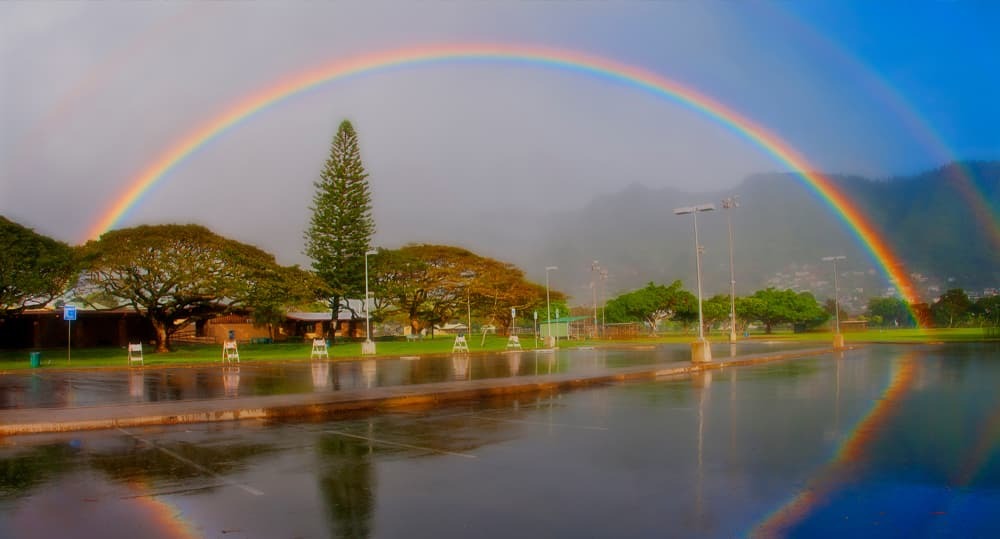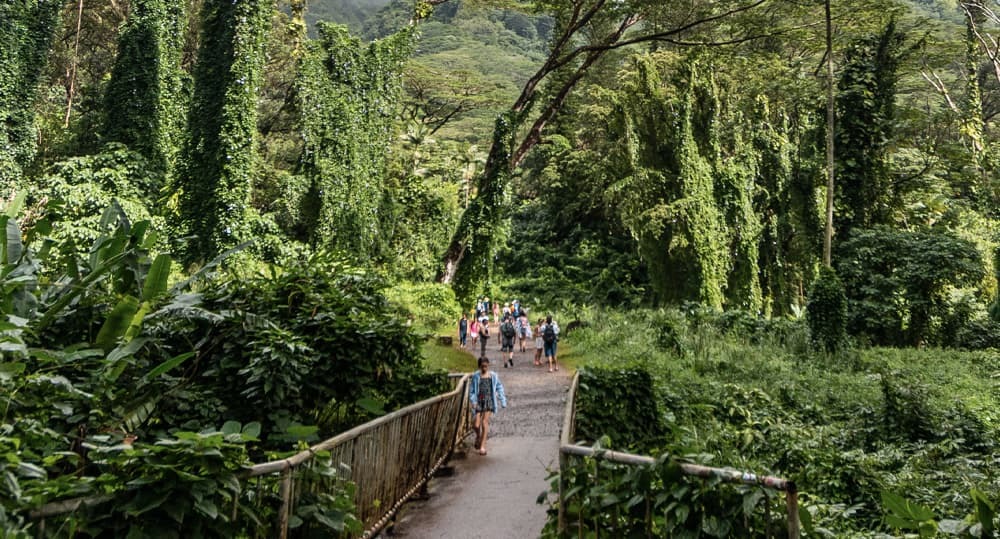Honolulu Real Estate
Honolulu is the largest city and the capital of the state of Hawaii.
Manoa offers quiet elegance with an eclectic offering of architectural styles from bygone eras in its oldest neighborhoods. Farther into the valley are lovely mid-century homes on quiet country lanes bordered by iconic monkey pod trees. The surrounding valley walls provide a stunning backdrop. And higher on the sloping walls, custom homes harmonize with the natural environment and provide scenic views of the valley, Honolulu, and the blue Pacific.
Manoa extends from the edge of urban Honolulu to the back of the elongated Manoa Valley. Lower Manoa is densely populated with condos and single-family homes, some heritage homes. As the valley walls begin to rise, there is a definite change to a more country-like atmosphere. There are few sidewalks here, and homes reflecting styles of earlier eras are on large lots with huge shade trees and trimmed hedges.
No other concentrated area on Oahu has as many historic residences – or as many examples of architectural styles popular during various earlier eras.
The Seaview Tract, the beginning of the subdivision concept on Oahu, was created in lower Manoa in 1886. In 1901, the trolley was extended up Manoa Rd. nearer to the agricultural and dairy land in the valley. The concept was to bring potential future residents into the area. That same year, Oahu College (Punahou School today) sold a portion of its property as a tract of lots named College Hills. The area today is between Punahou School and the mauka campus of University of Hawai’i at Manoa. One of the tract’s historic homes is now the university’s residence for its president.
The eclectic mix of styles appeared as the area expanded beyond College Hills with more residential development in the 1920s. Lovely neighborhoods host examples of Queen Anne, Tudor, Gothic Revival, Classic Colonial, and still others. Many variations of the craftsman bungalow and Hawaiian cottage styles were very popular and are still popular today. Touring through historic Manoa is a glimpse of affluent residential living on Oahu during the first half of the twentieth century, and yet so inexplicably Hawaiian. The quaint, charming statement of these homes has withstood time, and the neighborhoods are as desirable as ever.
Beyond these gateway neighborhoods, residential homes continue into the valley and along its slopes. Many homes are newer modified Hawaiian plantation, cottage, and ranch styles, and mid-century modern. On the higher elevations are large custom homes in contemporary styles with extended lanais and blending indoors with the lush rainforest and tropical surroundings.
Condominiums cluster in Lower Manoa with a few low-rise townhouse/condo developments farther in the valley.
Nearly all of Manoa's real estate is desirable. Besides its beautiful scenery and comfortable ambiance, it is close to cultural centers, shopping, downtown, Waikiki, beaches, boat harbors, beautiful parks, and golf courses. From Manoa, it is easy to access freeways and roads going everywhere on Oahu.
Aria Lane Manoa will offer both market and affordable housing.
The current median (June 2022) list price in Manoa is $1,500,000, ranging from the $350,000s for condos in Lower Manoa to an atypical $5,000,000-$6,000,000 Manoa Valley estate.
Love the style, but can't find what you're looking for?
Homes for sale in Kaimuki have a lot of charm as well. Kaimuki is slightly more upbeat with its newer restaurants and shops, however, the house styles, price points, and historic vibes are alike.
Since Manoa claims the earliest residential communities beyond urban Honolulu, settled in part by many of the early Honolulu commercial pioneers, one might say that Manoa speaks for itself. Residents are proud of their addresses in a quietly dignified Manoa. And the community works together to preserve its historic identity, including its native trees and plants.
Many of today’s successful residents trace their heritage to the early Japanese and Chinese immigrants who worked in Honolulu and the Manoa Valley. Today, Asians comprise the largest percentage of residents in Manoa.
Manoa’s charm and quiet living attract retirees; however, I suspect that many retirees are residents who have lived in Manoa for decades and have no desire to live elsewhere.
The commute from Manoa to Bishop Street is about 15-25 minutes, depending on the hour. Unlike neighborhoods that have to use the crowded freeways during rush hour, residents can use alternate routes on Honolulu streets. Many commuters in Manoa carpool and use a smartphone traffic app to find the best timesaving route when traffic is heavy.
The average daily annual temperatures in Manoa range between 65°F (18°C) and 88°F (31°C), but can change farther into the valley.
The average rainfall is generally greatest in the winter months when it can be 5-6 inches or more. Again, the amount of rain increases farther into the valley. The rains engender the lush growth throughout the valley and produce beautiful rainbows.
Manoa is well below the national average in violent crimes but above the national average in property crimes. In 2020, Manoa was about 20% above the national average and 2% above the state average in property crime but almost 20% below the urban Honolulu average, according to Areavibes.
Manoa has two highly-rated public elementary schools (PK-5). Voyager Public Charter School (K-8), also in Manoa, is rated above average. The public middle school (6-8) and high school (9-12) are located in nearby neighborhoods.
There are three esteemed private schools in Manoa: Punahou School (K-12), Mid Pacific Institute (PK-12), and Maryknoll School (K-12). Manoa also has several pre kindergarten schools.
University of Hawai’i (UH) at Manoa in Lower Manoa offers undergraduate, graduate, and doctoral degrees. UH also has a medical school.
Learn more about Manoa's schools from a local's perspective.
Tucked in the very back of Manoa Valley, Manoa Falls is an iconic treasure of the valley. Less than two miles round trip, the hiking trail is a relatively easy but muddy walk through the rainforest. As a resident, it can be fun to join the tourists and hear what they have to say about the trail and the 100-foot falls!
For the dedicated hiker, several hiking trails meander around the valley.
Close to the start of the Manoa Falls hiking trail is the Lyon Arboretum, almost 200 acres of beautiful rainforest botanical gardens and tranquil water features. More hiking trails are here also. The arboretum borders the Honolulu Watershed Forest Reserve.
Another gem that residents take pride in is the Manoa Heritage Center on the property of one of Manoa’s historic Tudor homes. An education center and reconstructed heiau (Hawaiian temple) are on the grounds. The vision is “to engage audiences more deeply with Hawai’i’s incredible biocultural diversity.”
Centrally located in Manoa is the city and county’s district park with a gym, tennis/pickleball and basketball courts, baseball fields, a swimming pool, and large grassy areas.
Learn more about the fun activities available in Manoa.
Several of these nosheries are located in the Manoa Marketplace and include ethnic delights such as Japanese, Korean, Hawaiian, and Vietnamese, among other restaurant offerings. Three days during the week, the Manoa Farmers Market is open here also.
The Waioli Kitchen & Bake Shop, in the historic Waioli Tea Room premises, may be said to be “doubly good.” Serving a simple but delicious breakfast and lunch menu of items, the restaurant employs hardworking personnel trying to turn their lives around. Dining at Waioli Kitchen & Bake Shop offers the nostalgia of an inspiring earlier era of good intentions as well as a mouthful of tasty treats.
Honolulu is the largest city and the capital of the state of Hawaii.
A whopping 27 neighborhoods makes up the city of Hawaii Kai.
A mom-and-pop neighborhood evolving from historic to hip.
Newly built condos, microbreweries, hidden speakeasies, and more.
Hawaii’s first planned community, located in central Oahu.
Living in Waikiki is like being on vacation year-round.
An iconic neighborhood known for its luxury oceanfront homes.
An older neighborhood located north of Pearl Harbor.




